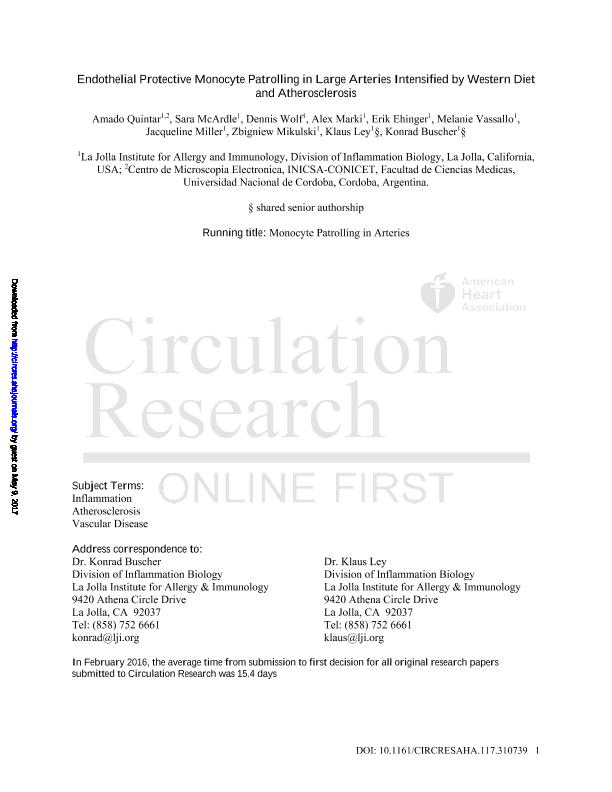Mostrar el registro sencillo del ítem
dc.contributor.author
Quintar, Amado Alfredo

dc.contributor.author
McArdle, Sara
dc.contributor.author
Wolf, Dennis
dc.contributor.author
Marki, Alex
dc.contributor.author
Ehinger, Erik
dc.contributor.author
Vassallo, Melanie
dc.contributor.author
Miller, Jacqueline
dc.contributor.author
Mikulski, Zbigniew
dc.contributor.author
Ley, Klaus Friedrich

dc.contributor.author
Buscher, Konrad
dc.date.available
2018-08-31T16:24:20Z
dc.date.issued
2017-03
dc.identifier.citation
Quintar, Amado Alfredo; McArdle, Sara; Wolf, Dennis; Marki, Alex; Ehinger, Erik; et al.; Endothelial protective monocyte patrolling in large arteries intensified by western diet and atherosclerosis; Lippincott Williams; Circulation Research; 120; 11; 3-2017; 1789-1799
dc.identifier.issn
0009-7330
dc.identifier.uri
http://hdl.handle.net/11336/57885
dc.description.abstract
Non-classical mouse monocyte (CX3CR1, Ly-6C) patrolling along the vessels of the microcirculation is critical for endothelial homeostasis and inflammation. Due to technical challenges it is currently not established how patrolling occurs in large arteries. OBJECTIVE:: This study was undertaken to elucidate the molecular, migratory and functional phenotype of patrolling monocytes in the high shear and pulsatile environment of large arteries in healthy, hyperlipidemic and atherosclerotic conditions. METHODS AND RESULTS:: Applying a new method for stable, long-term two-photon intravital microscopy of unrestrained large arteries in live CX3CR1-GFP mice, we show that non-classical monocytes patrol inside healthy carotid arteries at a velocity of 36 μm/min, three times faster than in microvessels. The tracks are less straight but lead preferentially downstream. The number of patrolling monocytes is increased 9-fold by feeding wildtype mice a western diet or by applying topical TLR7/8 agonists. A similar increase is seen in CX3CR1/apoE mice on chow diet, with a further 2-3-fold increase on western diet (22-fold over healthy). In plaque conditions, monocytes are readily captured onto the endothelium from free flow. Stable patrolling is unaffected in CX3CR1-deficient mice and involves the contribution of LFA-1 and α4 integrins. The endothelial damage in atherosclerotic carotid arteries was assessed by electron microscopy and correlates with the number of intraluminal patrollers. Abolishing patrolling monocytes in Nr4a1 apoE mice leads to pronounced endothelial apoptosis. CONCLUSIONS:: Arterial patrolling is a prominent new feature of non-classical monocytes with unique molecular and kinetic properties. It is highly upregulated in hyperlipidemia and atherosclerosis in an CX3CR1-independent fashion, and plays a potential role in endothelial protection.Circulation Research is published on behalf of the American Heart Association, Inc., by Wolters Kluwer. This is an open access article under the terms of the Creative Commons Attribution Non-Commercial-NoDerivs License, which permits use, distribution, and reproduction in any medium, provided that the original work is properly cited, the use is noncommercial, and no modifications or adaptations are made.
dc.format
application/pdf
dc.language.iso
eng
dc.publisher
Lippincott Williams

dc.rights
info:eu-repo/semantics/openAccess
dc.rights.uri
https://creativecommons.org/licenses/by-nc-sa/2.5/ar/
dc.subject
Patrolling Monocytes
dc.subject
Atherosclerosis
dc.subject
Endothelium
dc.subject
Live Imaging
dc.subject.classification
Inmunología

dc.subject.classification
Medicina Básica

dc.subject.classification
CIENCIAS MÉDICAS Y DE LA SALUD

dc.title
Endothelial protective monocyte patrolling in large arteries intensified by western diet and atherosclerosis
dc.type
info:eu-repo/semantics/article
dc.type
info:ar-repo/semantics/artículo
dc.type
info:eu-repo/semantics/publishedVersion
dc.date.updated
2018-08-29T18:38:26Z
dc.identifier.eissn
1524-4571
dc.journal.volume
120
dc.journal.number
11
dc.journal.pagination
1789-1799
dc.journal.pais
Estados Unidos

dc.journal.ciudad
Philadelphia
dc.description.fil
Fil: Quintar, Amado Alfredo. La Jolla Institute for Allergy and Immunology; Estados Unidos. Consejo Nacional de Investigaciones Científicas y Técnicas. Centro Científico Tecnológico Conicet - Córdoba. Instituto de Investigaciones en Ciencias de la Salud. Universidad Nacional de Córdoba. Instituto de Investigaciones en Ciencias de la Salud; Argentina
dc.description.fil
Fil: McArdle, Sara. La Jolla Institute for Allergy and Immunology; Estados Unidos
dc.description.fil
Fil: Wolf, Dennis. La Jolla Institute for Allergy and Immunology; Estados Unidos
dc.description.fil
Fil: Marki, Alex. La Jolla Institute for Allergy and Immunology; Estados Unidos
dc.description.fil
Fil: Ehinger, Erik. La Jolla Institute for Allergy and Immunology; Estados Unidos
dc.description.fil
Fil: Vassallo, Melanie. La Jolla Institute for Allergy and Immunology; Estados Unidos
dc.description.fil
Fil: Miller, Jacqueline. La Jolla Institute for Allergy and Immunology; Estados Unidos
dc.description.fil
Fil: Mikulski, Zbigniew. La Jolla Institute for Allergy and Immunology; Estados Unidos
dc.description.fil
Fil: Ley, Klaus Friedrich. La Jolla Institute for Allergy and Immunology; Estados Unidos
dc.description.fil
Fil: Buscher, Konrad. La Jolla Institute for Allergy and Immunology; Estados Unidos
dc.journal.title
Circulation Research

dc.relation.alternativeid
info:eu-repo/semantics/altIdentifier/doi/http://dx.doi.org/10.1161/CIRCRESAHA.117.310739
dc.relation.alternativeid
info:eu-repo/semantics/altIdentifier/url/https://www.ahajournals.org/doi/10.1161/CIRCRESAHA.117.310739
Archivos asociados
